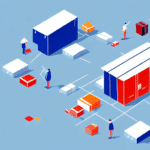An Overview and Features of Logistics Enhanced Solutions for 3PL Logistics Fulfillment
In today's fast-paced and ever-evolving supply chain industry, the significance of third-party logistics (3PL) fulfillment cannot be overstated. As businesses endeavor to meet the surging demands of their customers while maintaining cost-efficiency, outsourcing logistics fulfillment services to 3PL providers has surged in popularity. According to a recent industry report by Statista, the global 3PL market is expected to reach $1.75 trillion by 2027, growing at a compound annual growth rate (CAGR) of 8.4% from 2020.
Despite its advantages, the increasing reliance on 3PLs introduces a set of challenges that businesses must navigate to ensure seamless 3PL logistics fulfillment operations. Implementing logistics enhanced solutions is critical to addressing these challenges and optimizing the supply chain.
Understanding the Role of 3PL Logistics Fulfillment in Modern Supply Chains
Before delving into the benefits and challenges of logistics enhanced solutions for 3PL logistics fulfillment, it is essential to comprehend the pivotal role that 3PLs play in contemporary supply chains. Third-party logistics (3PL) providers specialize in managing the entire logistics process, encompassing everything from inventory management to order fulfillment and transportation.
Outsourcing logistics fulfillment to 3PL companies allows businesses to leverage specialized expertise and advanced resources, facilitating a focus on core competencies. This partnership can result in improved operational efficiency, reduced delivery times, and enhanced customer satisfaction. According to a study by the Council of Supply Chain Management Professionals, companies using 3PL services report a 15% increase in operational efficiency and a 10% reduction in logistics costs.
Moreover, 3PL logistics fulfillment offers businesses greater flexibility and scalability. As organizations expand, their logistics requirements evolve. By partnering with 3PL providers, businesses can easily scale their logistics operations to accommodate growth without substantial investments in additional infrastructure, thereby maintaining agility and competitiveness in the dynamic market landscape.
Key Challenges Facing 3PL Logistics Fulfillment and How Technology Can Help
Despite the obvious benefits of 3PL logistics fulfillment, various challenges can hinder the smooth operation of fulfillment services. One of the most significant challenges is visibility, or the ability to monitor the status and location of shipments in real-time. Limited visibility can lead to inefficiencies, delays, and reduced customer satisfaction.
Fortunately, technological advancements have made overcoming this challenge more feasible. Logistics enhanced solutions, such as advanced tracking and monitoring systems, enable businesses to gain real-time visibility into their supply chain. This capability allows for data-driven decision-making, improved logistics efficiency, and enhanced ability to respond to disruptions swiftly. For instance, real-time tracking solutions can provide end-to-end visibility, ensuring that all stakeholders are informed about shipment statuses at any given moment.
Another challenge faced by companies in 3PL logistics fulfillment is efficient inventory management. Managing multiple warehouses and distribution centers can complicate inventory tracking, leading to stockouts or overstocking, which ultimately results in lost revenue. Implementing inventory management software and automated systems can mitigate these issues by providing real-time tracking of inventory levels, optimizing warehouse space, and reducing the risks associated with inaccurate inventory data. According to a report by the Inventory Management Institute, businesses that adopt automated inventory solutions see a 20% reduction in inventory inaccuracies.
The Evolution of Logistics Enhanced Solutions for 3PL Logistics Fulfillment
Over the years, logistics enhanced solutions have undergone significant evolution, driven by the introduction of innovative technologies. These advancements have transformed the logistics landscape, enabling businesses to optimize their fulfillment processes and reduce operational costs.
Key advancements in logistics enhanced solutions include the integration of data analytics, automation, and artificial intelligence (AI). Data analytics allows businesses to analyze large volumes of data to identify trends, forecast demand, and make informed decisions. Automation streamlines repetitive tasks such as order processing and inventory updates, reducing the potential for human error and increasing operational efficiency. AI technologies, including machine learning algorithms, enhance predictive capabilities and optimize routing and scheduling, further improving the accuracy and efficiency of logistics operations.
Sustainability has also become a critical focus in the evolution of logistics enhanced solutions. With increasing environmental concerns, businesses are adopting eco-friendly practices such as using electric vehicles, optimizing delivery routes to minimize fuel consumption, and implementing recycling programs to reduce waste. These sustainable practices not only contribute to environmental conservation but also result in long-term cost savings. A study by Energy Star indicates that companies implementing sustainable logistics practices can reduce operational costs by up to 12% annually.
Exploring the Benefits of Logistics Enhanced Solutions for 3PL Logistics Fulfillment
Logistics enhanced solutions offer a multitude of benefits to 3PL logistics fulfillment operations, significantly impacting efficiency, visibility, and cost management.
- Improved Efficiency: By automating tasks and optimizing processes, businesses can decrease the time required for order fulfillment, enabling faster response to customer demands.
- Increased Visibility: Access to real-time data and analytics provides valuable insights into the supply chain, facilitating informed decision-making and identification of improvement areas.
- Cost Reduction: Streamlined processes and error reduction lead to savings on labor and materials. Additionally, optimized inventory management minimizes excess stock and associated costs.
- Sustainability: Enhanced solutions support eco-friendly initiatives, such as reducing waste and minimizing carbon footprints, which can also translate to financial savings over time.
Furthermore, enhanced logistics solutions can drive customer satisfaction by ensuring timely deliveries and accurate order tracking, fostering customer loyalty and repeat business.
How to Choose the Right Logistics Enhanced Solution for Your 3PL Logistics Needs
Selecting the appropriate logistics enhanced solution requires a thorough assessment of your specific business needs and operational requirements. Here are key steps to guide the selection process:
- Assess Your Supply Chain: Evaluate the size and complexity of your supply chain, including the number of warehouses, distribution centers, and the nature of your products.
- Identify Key Requirements: Determine the functionalities you need, such as real-time tracking, inventory management, automation capabilities, and scalability options.
- Evaluate Integration Capabilities: Ensure that the logistics solution can seamlessly integrate with your existing systems, including accounting software and customer relationship management (CRM) platforms.
- Consider Scalability: Choose a solution that can grow with your business, accommodating increased volume and complexity as your operations expand.
- Review Vendor Reputation: Partner with reputable vendors with proven track records and positive customer reviews to ensure reliability and support.
By meticulously evaluating these factors, businesses can select a logistics enhanced solution that aligns with their goals, enhances operational efficiency, and supports long-term growth.
Comparing Different Types of Logistics Enhanced Solutions for 3PL Logistics Fulfillment
The market offers a diverse array of logistics enhanced solutions, each tailored to specific aspects of the logistics process. Key types include:
- Warehouse Management Systems (WMS): These systems optimize warehouse operations by managing inventory levels, streamlining order picking, and improving space utilization.
- Transportation Management Systems (TMS): TMS solutions focus on optimizing transportation logistics, including route planning, carrier selection, and freight auditing.
- Order Management Systems (OMS): OMS platforms facilitate the efficient processing of orders from placement to delivery, ensuring accuracy and timely fulfillment.
When comparing these solutions, consider factors such as cost, functionality, and ease of use. Additionally, evaluate the scalability of the solution to ensure it can accommodate future growth and the ability to integrate with your existing systems for a seamless operational workflow.
Another critical factor is the solution’s ability to provide real-time analytics and reporting capabilities, which are essential for monitoring performance and making data-driven decisions. A comprehensive comparison will help identify the best-fit solution that meets your specific logistics needs and enhances overall fulfillment efficiency.
Implementing a Successful Logistics Enhanced Solution for Your 3PL Operations
Implementing a logistics enhanced solution within your 3PL logistics fulfillment operations requires strategic planning and careful execution to ensure success. Here are essential steps for a smooth implementation:
- Define Clear Objectives: Identify the goals you aim to achieve with the new logistics solution, such as improving efficiency, enhancing visibility, or reducing costs.
- Develop an Implementation Plan: Collaborate with the solution provider to create a detailed plan outlining the implementation timeline, key milestones, and resource allocation.
- Engage Stakeholders: Involve all relevant stakeholders, including employees, partners, and suppliers, to ensure buy-in and smooth adoption of the new system.
- Provide Comprehensive Training: Offer extensive training to your team to ensure they are proficient in using the new logistics solution and can leverage its full capabilities.
- Monitor and Evaluate Performance: Regularly assess the effectiveness of the implemented solution by tracking key performance indicators (KPIs) and gathering feedback to identify areas for improvement.
Additionally, maintaining open communication with the solution provider during and after implementation can help address any challenges promptly and ensure continuous optimization of your logistics operations.
Best Practices for Maximizing the Efficiency of Your 3PL Logistics Fulfillment with Logistics Enhanced Solutions
To fully leverage logistics enhanced solutions and maximize the efficiency of your 3PL logistics fulfillment operations, adhering to best practices is essential. Key practices include:
- Regular Data Monitoring: Continuously monitor your supply chain data to identify trends, potential bottlenecks, and areas for improvement.
- Process Optimization: Streamline your logistics processes by eliminating redundancies, automating repetitive tasks, and implementing standardized procedures.
- Continuous Training: Invest in ongoing training and development for your employees to keep them updated on the latest technologies and best practices.
- Embrace Technological Innovations: Stay informed about emerging logistics technologies and integrate them into your operations to maintain a competitive edge.
- Foster Strong Collaboration: Establish robust communication channels and collaborative relationships with your logistics providers to facilitate seamless operations and mutual growth.
Implementing these best practices will not only enhance the efficiency of your logistics fulfillment but also drive overall business performance and customer satisfaction.
Future Trends and Innovations in the Field of Logistics Enhanced Solutions for 3PL Logistics Fulfillment
The field of logistics enhanced solutions for 3PL logistics fulfillment is continuously evolving, with several emerging trends and innovations set to reshape the industry in the coming years:
- Increased Automation: Automation technologies, including robotics and autonomous vehicles, are becoming more prevalent, streamlining warehouse operations and reducing labor costs.
- Artificial Intelligence Integration: AI-powered solutions enhance predictive analytics, demand forecasting, and route optimization, leading to more efficient and responsive supply chains.
- Blockchain Technology: Blockchain offers a secure and transparent method for tracking goods and transactions, reducing fraud, and improving supply chain visibility. As adoption grows, blockchain is expected to become a cornerstone of logistics operations.
- Internet of Things (IoT): IoT devices provide real-time tracking and monitoring of shipments, enabling proactive management of the supply chain and improved decision-making.
- Green Logistics: Sustainable logistics practices are gaining traction, with a focus on reducing carbon footprints through eco-friendly transportation methods and sustainable packaging solutions.
Businesses that proactively adopt these trends and invest in innovative logistics enhanced solutions will be well-positioned to stay ahead of the competition and meet the evolving demands of the market.
One of the most promising innovations is the use of blockchain technology in logistics. By offering an immutable ledger for recording transactions, blockchain enhances trust and transparency among all supply chain participants. This technology can significantly reduce fraud, streamline documentation processes, and provide unparalleled visibility into the movement of goods. As blockchain technology matures and becomes more widely adopted, its impact on the logistics industry is expected to be profound.
Conclusion
In conclusion, logistics enhanced solutions provide numerous advantages to 3PL logistics fulfillment, including improved efficiency, enhanced visibility, cost reductions, and increased customer satisfaction. However, successfully implementing these solutions requires careful planning, ongoing training, and a willingness to embrace change.
As the landscape of logistics enhanced solutions for 3PL logistics fulfillment continues to evolve, businesses that invest in the latest technologies and innovations will be better positioned to maintain a competitive edge and achieve long-term success in their logistics operations.
One of the key benefits of logistics enhanced solutions is the capability to track shipments in real-time. This feature allows businesses to provide customers with accurate and up-to-date information regarding their orders, thereby enhancing customer satisfaction and loyalty. Additionally, real-time tracking helps businesses identify and mitigate any issues or delays in the supply chain promptly, ensuring timely deliveries and minimal disruptions.
Another significant advantage is the ability to optimize inventory management. Utilizing advanced analytics and forecasting tools enables businesses to gain deeper insights into their inventory levels and demand patterns. This understanding facilitates more informed decision-making regarding order quantities and timing, reducing inventory carrying costs, minimizing stockouts, and enhancing overall supply chain efficiency.




















